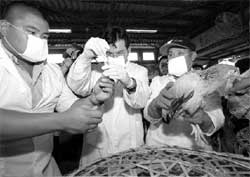Evolutionary drama
 Our relationship with infectious pathogens is a part of our evolutionary drama. Simply put, microorganisms have a selfish interest in our survival. When humans develop resistance to the pathogen’s virulence, the pathogen finds ways to evade this acquired immunity. This cat and mouse relationship is central to this drama.
Our relationship with infectious pathogens is a part of our evolutionary drama. Simply put, microorganisms have a selfish interest in our survival. When humans develop resistance to the pathogen’s virulence, the pathogen finds ways to evade this acquired immunity. This cat and mouse relationship is central to this drama.
Historically, the emergence of disease is possibly related closely to humans furrowing the Earth for cultivating crops and domesticating animals. With the dog came measles, the cow brought home tuberculosis and diphtheria after it grazed along with wild deer and antelopes, influenza hitch hiked upon horses, and anthrax popped out of the soil and infected humans and animals.
Diseases that emerge due to ecological changes and deforestation is possibly the most important among these. In tropical forests, deforestation releases vectors like mosquitoes and ticks, which compete for the limited resources that remain. Deforestation in forest fringes exposes land to sunlight and promotes the development of temporary pools of water, thus favouring the breeding of human-biting, fever-transmitting mosquitoes. Almost all biting insects carry or can potentially carry a pathogen. A clearance usually leads to establishments of forest villages of communities that migrate from other places.
Large mammals like pigs, antelopes, rodents and bats among others are reservoirs of food for vectors and a breeding ground for pathogens. When a few reservoirs are left, vectors explore new options which brings them in contact with the newly settled humans. The real challenge for an organism, if it has to establish as a new human disease, is to develop the ability to infect humans consistently and also develop a reliable means of transmission through a vector between the reservoir and a new host, humans. As in the case of ebola.
The ebola virus first emerged in two major disease outbreaks, which occurred almost simultaneously in Zaire and Sudan in 1976. Over 500 cases were reported, with mortality rates of 88 per cent in Zaire and 53 per cent in Sudan. Richard Preston in his acclaimed book The Hot Zone startled the world saying that the resurfacing of viruses like ebola was due to ecological degradation.
In cities, changes in the urban ecosystems are frequent. Clogged sewers, mounting heaps of garbage, hospital wastes and intermixing of migrant populations promote the movement of the pathogens and explore new vectors. But why are cities like Kolkata or Siliguri more prone to such unknown diseases than others? Apparently it’s got to do with their geo-political positioning.
Let’s take Siliguri. It is perhaps the fastest growing city in West Bengal, with some of its wards recording a growth of over 200 per cent since the last census. The migrants from neighbouring countries contribute to much of its growth. Incidentally, Siliguri also happens to be one of the most porous areas of the country sharing its borders with Nepal, Bhutan and Bangladesh. Experts say that in the absence of a monitoring mechanism, there is no check on what sort of diseases are being carried by these people coming from other places.
Does a changing environmental and ecological equation have any significant role to play in this development? Environ mentalist Dhrubojyoti Ghosh believes that there is still insufficient data to indicate a clear cause-effect relationship between environment and unknown fever diseases. However, the role of degrading environment still cannot be entirely ruled out as it is common knowledge that vector-borne diseases thrive in such environs.
Breaking through
New infections emerge when an animal pathogen breaks the species barrier and infects human beings. Animal diseases that are capable of invading human cells (called zoonotic diseases), evade the host’s immune system, establish and reproduce in these cells and produce fevers, inflammation, bleeding and disorders as a symptom in the host.
David Conway and Cally Roper (International Journal of Parasitology , Vol 30 (2000) p1423
